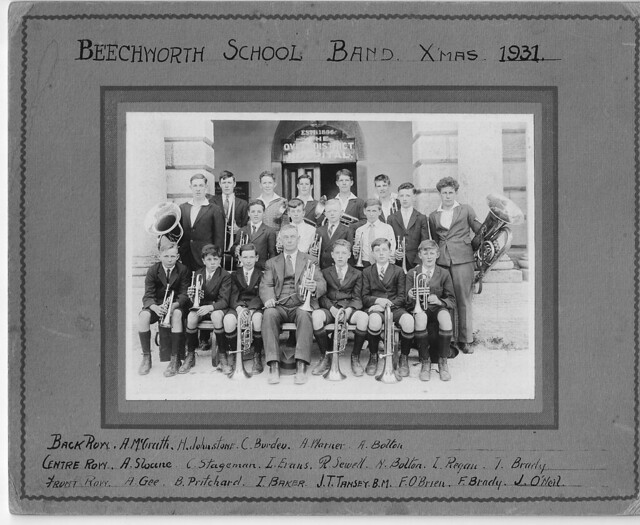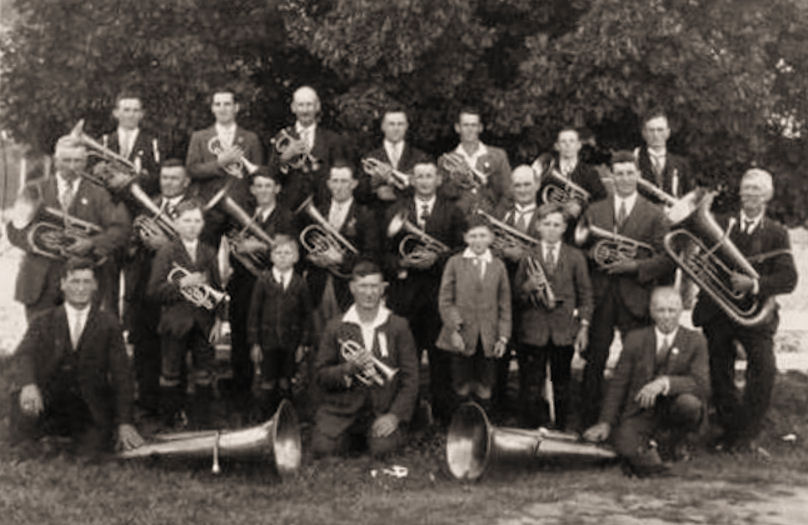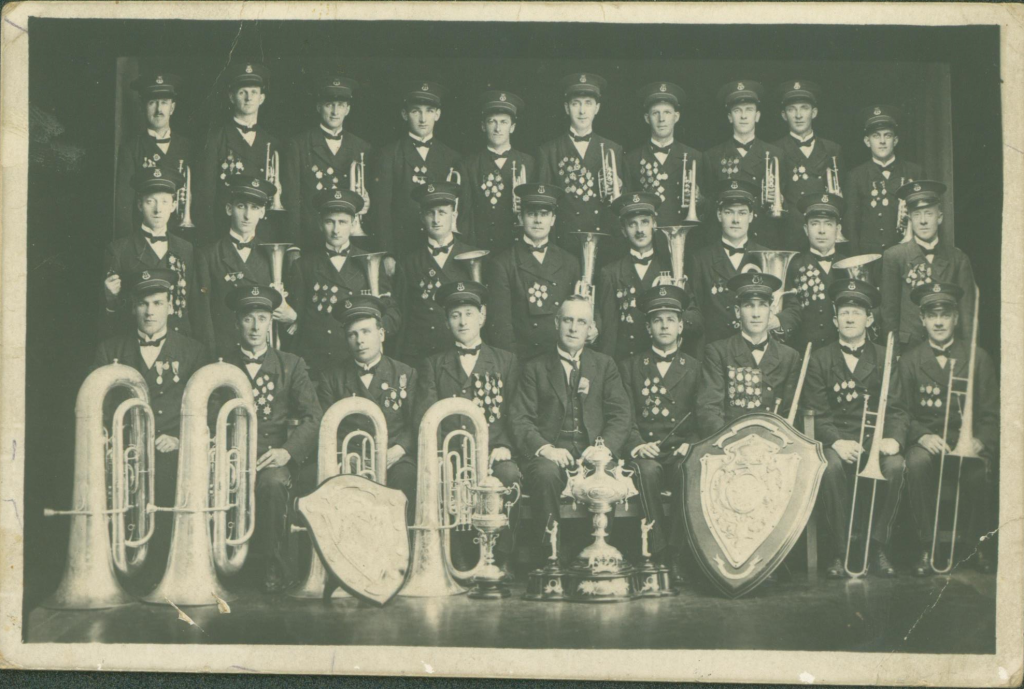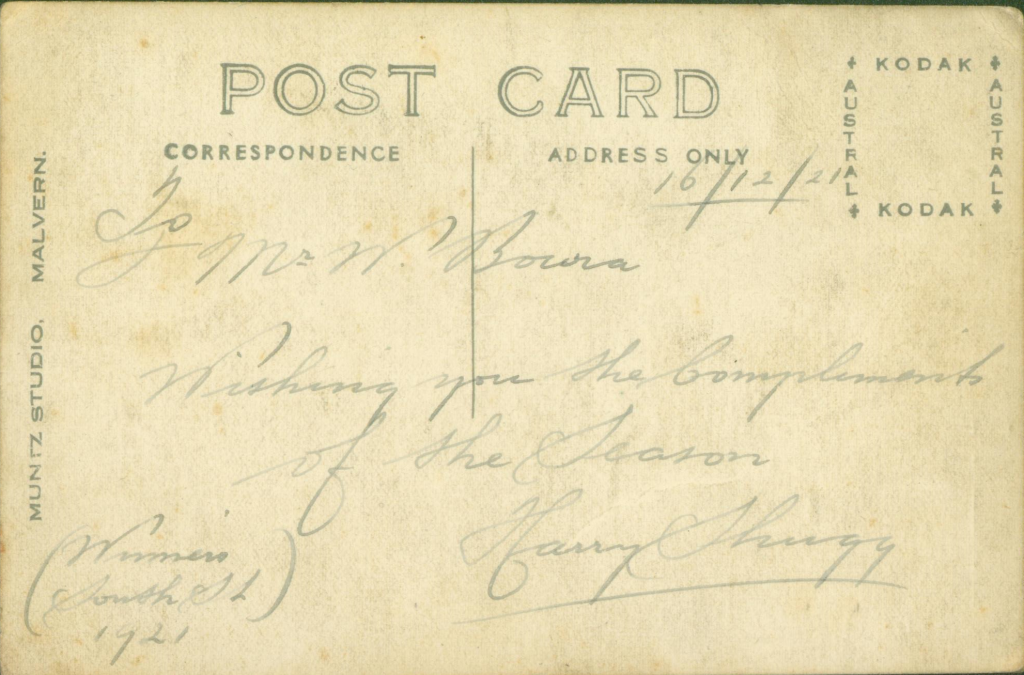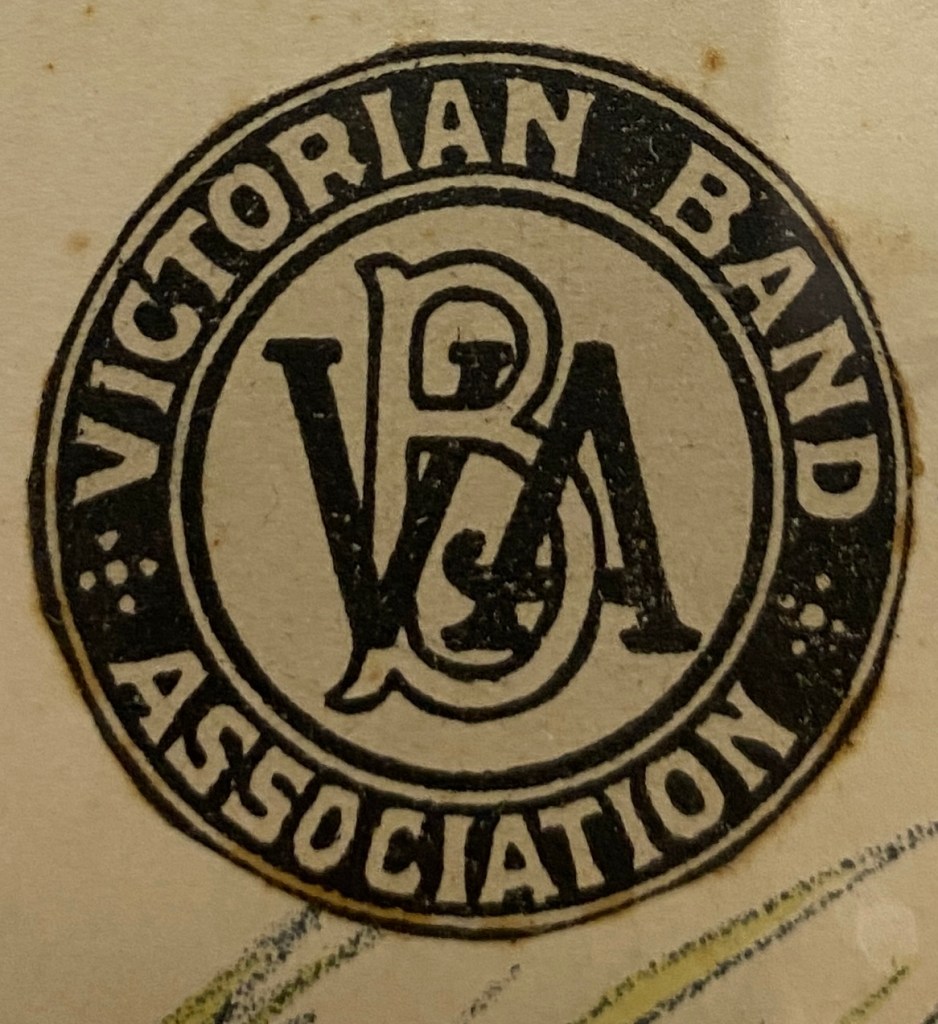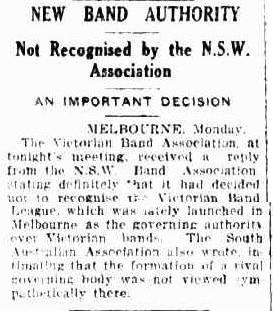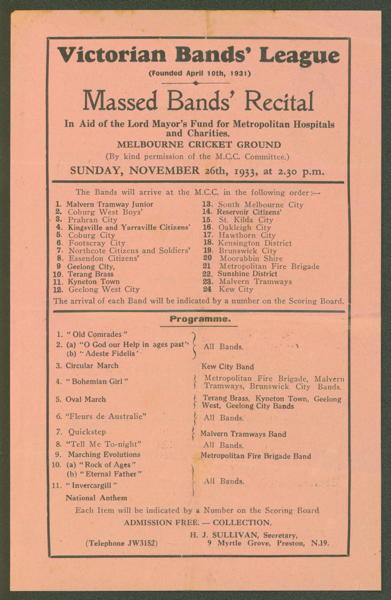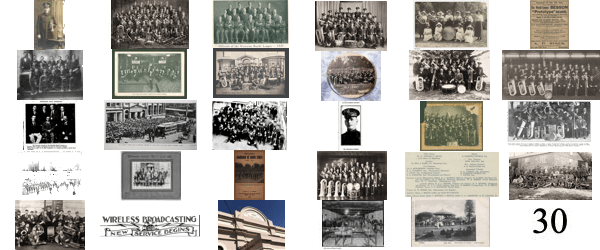
Introduction:
My favourite period of band life in Australia is between 1900-1950 and the posts on this blog reflect this. It is a time of rapid development of bands in this country and tied in with major historical events (Wars, a pandemic and the Great Depression), the life of bands was certainly eventful. It was also a time of great musical achievement in the band scene with many fine bands coming to the fore, competitions gaining national prominence, and individual band members becoming household names.
It would be fair to say that bands create their own history, and we can see early bands come to life again through articles and newspaper reports. Such is the passage of time; the early bands inform the life of their contemporary iterations. Modern-day bands can and do look back and wonder. Yet the modern-day bands celebrate achievement and mark their own yearly history the same way their forebears did. Each annual general meeting is a testament to this!
The theme of this blog post is around the number thirty. Forgive the slight indulgence, this also marks the thirtieth blog post of “Band Blasts from the Past”. The early bands were probably very pleased they had reached a thirty. It is not just a number, it is the number of members, age of a band, and even a part of local history.
Thirty members:
What is a band without members? Not much. So, it is no surprise that the bands of old made mention of the numbers of members who had signed up to bands, attended annual general meetings, or played in concerts. It is worthwhile to read of such numbers as they tell us how the band was travelling over time. Of course, bands at this time consisted of all manner of numbers from the very small to the very big, but generally based on the ideal of twenty-eight brass musicians and a couple of percussionists – thirty members (not including the band master) (Myers, 2000).

“New Caulfield Brass Band” was the headline of a tiny article that was published in the Herald newspaper on the 22nd of August 1913. Whoever was starting this new band was proud to say that “Thirty men gave in their names as willing to join” (“New Caulfield Brass Band.,” 1913). Whether that same thirty continued on this path is another matter.
Forming boys and school bands was sometimes more successful and the young band members were very enthusiastic. The East State School in Toowoomba, Queensland was one such school that formed a band, an idea which grew to fruition thanks to a committee of teachers, parents and the conductor of the local Toowoomba Musical Union, a Mr. T. Slatyer (“EAST STATE SCHOOL,” 1933). Thirty boys were part of the initial brass band. Likewise, a boy’s brass band was proposed in the town of Mooroopna near Shepparton, Victoria. At the initial meeting, thirty applications were received and those proposing this new band were encouraging but urged some caution.
Mr. N. L. McKean told the boys who attended that patience and hard practice would be needed for success. His remarks were supported by Mr. P. Harrington, and the bandmaster (Mr. McCaskill) urged the boys to consider the matter very carefully
(“MOOROOPNA NEWS,” 1936)
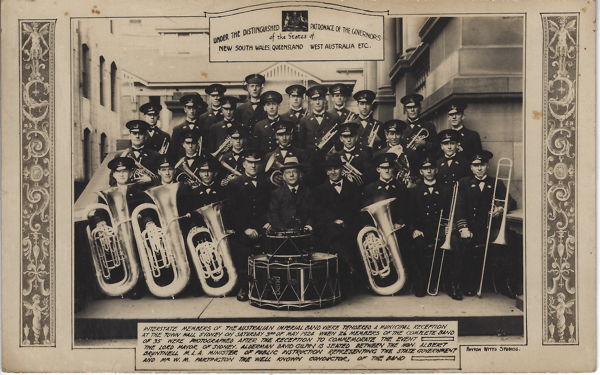
Backtracking slightly in time, the Australian Imperial Band was formed in 1924 with the grand intention of travelling around Australia, and then to England to compete against the best of British brass bands. We know from a previous post what happened to the tour as the band never made it to England due to lack of funds (de Korte, 2019). However, newspaper articles, such as this one published in the Sunraysia Daily newspaper in January 1924, proudly proclaimed that thirty of Australia’s leading bandsmen were “To be Chosen from All States for Wembley” and that there were “Engagements Assured” (“AUSTRALIAN BRASS BAND,” 1924).

In October 1924, thirty performers of the Wagga Wagga Brass Band provided a varied recital to an enthusiastic crowd in one of the town parks (“WAGGA BRASS BAND.,” 1924). The local Daily Advertiser newspaper duly published an account of the evening and even listed all the pieces that were played (as can be seen in the article above).

Down south in Tasmania, a letter writer with the band-like pseudonym of “Tenor Horn” wrote to the Northern Standard newspaper to proudly proclaim that the thirty members of the Ulverstone Brass Band were “progressing well” under a new bandmaster (Tenor Horn, 1922). Further north, in 1929 the Windsor Municipal Band of Queensland was also the subject of an article reporting on their progress.
Since the appointment of Mr. P. E. Lindsay as conductor of the Windsor Municipal Band six months ago, the band has made rapid strides. What was once an ordinary brass band of 11 players has now risen to the number of 30. A notable aspect is the new silver-plated instruments that have taken the place of the old brass ones, something like £250 having been spent on equipment.
(“Rapid Progress.,” 1929)
Sometimes, it was not all about how many members signed up to a band, attended a meeting or played at a concert although these are useful numbers. At times it was also about providing for a band and in 1948 we can see that the Echuca Brass Band did exactly that when they ordered 30 new uniforms costing £400 (“New Uniforms for Echuca Brass Band,” 1948).

First Intermission: Thirty shillings:
There is no doubt that some people were passionate about their local band. Not just passionate but parochial and sometimes felt that they were well-qualified to express their opinions (no matter if it was welcomed or not). And so, a very long letter by a contributor under the pseudonym of “Interested Citizen” was published in the Wellington Times newspaper in June 1922. The subject of his letter was a special meeting held by the local Wellington Municipal Band, a band located in the New South Wales Central West, regarding the current state of the band (Interested Citizen, 1922). In this letter of which a part will be quoted, he levels an amount of criticism however one aspect is the amount of pay given to the conductor.
However, I was indeed pleased to see that an attempt has been made to rally the band and send it along on a properly managed basis. It is an undeniable fact that of late the band has been going from bad to worse and in all probability would soon have dwindled into oblivion. But as I have stated an attempt has been made to stem the tide of destruction though in my opinion that attempt is doomed and will fall far short of its mark unless the committee acts promptly and in a business-like manner. First of all, I noticed that the bandmaster’s salary has been reduced from £2 to £1/10 per week. This is undoubtedly a step in the wrong direction, as it is ridiculous to expect any man who is not a resident of the town to apply for the position at thirty shillings per week and no guarantee of employment.
(Interested Citizen, 1922)
One can see the train of thought in this letter and also see that it is well-meaning. Why wouldn’t a local citizen write a seemingly logical letter like this? The thinking is sound; to build a better band you need the best person to do the job of bandmaster and the band will not attract this person to the town on a lower pay. After expressing opinions about which conductor in the town might be best qualified, “Interested Citizen” then writes:
I contend that the citizens of Wellington have had quite enough of low grade music and the time is now opportune for something practical to be done. If Wellington could pay its bandmaster £2 per week in the past, why not pay it in the future. If we cannot afford £2 for a capable man much less can we afford £1/10 for an incapable man. Wellington wants good music and we all realise that a first class man cannot be procured for a low grade pay. Therefore, I say. Keep up the standard, offer a salary that will induce talented musicians to apply and by doing so you will have taken the first step toward making a band that Wellington may well feel proud of.
(Interested Citizen, 1922)
Definitely opinionated, and he does have a valid point over the thirty-shilling difference in pay.
Thirty Years:

There are some curious aspects to reporting on a bands annual general meeting in various early newspapers. Some of them report everything verbatim. Others report what is needed and leave out parts. One of these was an article published in March 1927 by The Armidale Chronicle newspaper on the annual general meeting of the Armidale City Band. “Thirty Years Old” proclaims the headline, yet that is the only mention of age in the entire article (“Thirty Years Old.,” 1927). There is no doubt the band has done well for themselves in the preceding year. Membership has been solid, the band has appeared in numerous engagements, they are financially stable and possess a good set of instruments (“Thirty Years Old.,” 1927). Surely the paper would have made more mention of the bands age, but apparently not. At least though we have an indication in 1927 of how old the band actually is!
More meaningful is the various biographical entries on the famous bandsman, conductor and composer, Alexander Frame Lithgow. Originally from Scotland, Alex Lithgow spent much of his early life in New Zealand before moving to Tasmania where he conducted various bands in the Launceston area (Firth & Glover, 1986; Rimon, 2006). Lithgow “dominated Tasmanian band life for thirty years” (Rimon, 2006). Although, given his fame through his playing and compositions (especially the quick march “Invercargill), it could be argued that he dominated parts of Australian band life, if not parts of global band life as well (Firth & Glover, 1986; Glover, 2006; Rimon, 2006).
In October 1953 the Glen Innes Examiner newspaper published a worthwhile history of the Glen Innes Municipal Band with much of the information provided at the time by band member Mr. Andy Morton (“Municipal Band Has Outstanding Record,” 1953). This band, which by 1953 had reached an “unbroken sequence of 75 years”, boasted of many fine band members and conductors over time (“Municipal Band Has Outstanding Record,” 1953). One aspect of this history that stood out was how dedicated conductors were to this band.
Numerous others, also, were got their original training through the local band went on to do big things in music in Australia and elsewhere.
“For the last thirty years the band has been carried on by a bandmaster without pay.” Mr. Morton said.
“The present conductor, Mr. Eric Keating, is doing a wonderful job.”
“He is giving up one night a week for teaching beginners and general practices also take up a lot of his time.”
“Also, the band gives programmes in the park and at the hospital, and is always ready to perform at any function where a brass band is needed in the ceremony.”
(“Municipal Band Has Outstanding Record,” 1953)
Thirty years of commitment, of playing and dedication to community and band is a special milestone that needs to be celebrated.
Second Intermission: Thirty minutes:

As we saw in a previous post, the advent of gramophones and broadcasting led to a profound change in how Australians listened to and consumed music (de Korte, 2020). And with this new found listening came the inevitable letters to newspapers regarding how much or how little band music was being played over the wireless (de Korte, 2020). The Australian Broadcasting Commission (A.B.C.) bore the brunt of the letters as they were the major broadcasters of band music at the time– the organisation even had their own A.B.C. Military Band (de Korte, 2018).
With this in mind, in February 1940 a Mr. J. Grills sent a letter to The ABC Weekly newspaper.
I would like to hear more brass and military band music, and less of the tin-can jazz tripe. Thirty minutes is not long enough for band programmes. I would like to hear at least an hour’s session. Wouldn’t it be possible for The ABC Weekly to publish voting coupons for, say, three months with the features divided up into Classical Music, Talks, Jazz and so on. The programme compilers would then get an idea of what the listeners really prefer.
(Grills, 1940)
There is no doubting that band music was popular at the time, and certainly the A.B.C. Military Band was played at very regular times over the wireless (“NATIONAL MILITARY BAND SESSIONS,” 1941). Nevertheless, this letter from Mr. Grills was probably one of many sent to the A.B.C. on the same subject. It is but one of many opinions expressed during this time regarding bands and the wireless and certainly people had their musical tastes. Given the time Mr. Grills wrote this letter, it was in the early years of the Second World War and music from bands was inspiring to many (“NATIONAL MILITARY BAND SESSIONS,” 1941).
Thirty Years Ago:
We are all familiar with local newspapers of today publishing articles from many years ago to highlight local history as it is a fascination that has not dwindled over time. Unsurprisingly, we can find the same kinds of articles in early newspapers where they republished articles from previous editions that are decades old. Perhaps there was also a nostalgic interest in times past during these early years. Luckily, we can also find snippets of news regarding the local brass bands in these local history articles.
The year is 1932 and The Shoalhaven Telegraph newspaper was one that reprinted (rewrote) an article from February 1902. In this article we find all manner of news from 1902 including this small snippet:
Fancy Nowra having to secure a band from Kiama! Why don’t Shoalhaven people take steps to revive the town band?
(“Thirty Years Ago.,” 1933)
In the early 1900s, town bands came and went depending on circumstance, so it is no wonder that the town of Shoalhaven resented the fact that a band from Kiama was booked for an engagement instead.
In a similar style The Wooroora Producer newspaper from South Australia republished an article from a previous iteration of their newspaper, The Central Advocate. Their article was from 1903 where a plan was put in place to resurrect a band called the Balaklava Brass Band with instruments be sourced from the previous Federal Band (“Thirty Years Ago.,” 1933). The article from 1903 had a charming headline of “The Dead to be Raised” (“Thirty Years Ago.,” 1933).
A year later in 1934 we can find an interesting article published in The Catholic Press newspaper regarding events held thirty years earlier. In this reminiscing from 1904, the article makes mention of the Queanbeyan Brass Band playing at the local railway station to farewell a Priest who was about to take up duties at a Church in Sydney (“Do You Remember?,” 1934). Apparently the band played “Auld Lang Syne” with “heartfelt sympathy” (“Do You Remember?,” 1934).
A bit further north and in 1939, the Kyogle Examiner newspaper published articles from the same newspaper in 1909. Within this article (from 1909), we can see that the Kyogle Brass Band had held one of their regular meetings where correspondence was discussed and a vacancy on the committee was filled (“KYOGLE THIRTY YEARS AGO,” 1939). And in 1945, the Nurmurkah Leader newspaper published extracts from their “Leader File” where we find that in 1915, “an effort is being made to resuscitate the Nathalia Brass Band” (“What Hapened Thirty Years Ago,” 1945).

In another nod to local history, an excellent article was penned in the Newcastle Morning Herald and Miner’s Advocate by a Mr Leo Butler in June 1946. This article is a bit different to those mentioned above as it is not a republished extract from thirty years earlier. However, Mr Butler gives us a bit of history on the Mereweather Brass Band which was started in 1916 – and the article included cartoons of band events (Butler, 1946). It is a very entertaining and well-written read.
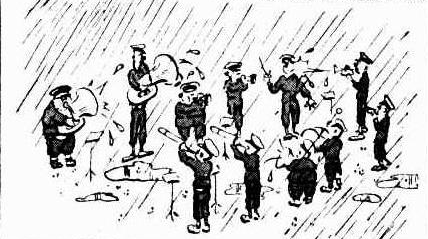
Conclusion:
Thirty members, thirty years, thirty years ago and some other thirties for good measure! The bands of the time may not have realised the history they were making when they made mention of these numbers in various iterations. And we cannot forget that the contribution of local newspapers when they republished articles from times past. All of this provides a historical context which is centred around a certain number.
References:
Armidale City Band. (n.d.). [Photograph]. [phot12333]. The Internet Bandsman Everything Within, Vintage Brass Band Pictures : Australia. http://www.ibew.org.uk/vbbp-oz.html
AUSTRALIAN BRASS BAND : To be Chosen from All States for Wembley : ENGAGEMENTS ASSURED. (1924, 10 January). Sunraysia Daily (Mildura, Vic. : 1920 – 1926), 3. http://nla.gov.au/nla.news-article258428082
A.B.C. Military Band – Conductor: Harry Shugg. (1930). [Postcard : L13.8cm – W8.8cm]. [0016]. Victorian Collections, Victorian Bands’ League. https://victoriancollections.net.au/items/5b39988221ea6d0008c461a6
Butler, L. (1946, 08 June). Band Began With “Grasp Of An English Hand”. Newcastle Morning Herald and Miners’ Advocate (NSW : 1876 – 1954), 5. http://nla.gov.au/nla.news-article140620196
de Korte, J. D. (2018, 12 July). The A.B.C. Military Band: an ensemble of the times. Band Blasts from the Past : Anecdotes, Stories and Personalities. https://bandblastsfromthepast.blog/2018/07/12/the-a-b-c-military-band-an-ensemble-of-the-times/
de Korte, J. D. (2019, 24 March). Names and status: the rare National and State bands. Band Blasts from the Past : Anecdotes, Stories and Personalities. https://bandblastsfromthepast.blog/2019/03/24/names-and-status-the-rare-national-and-state-bands/
de Korte, J. D. (2020, 03 August). Australian bands, gramophones and wireless: adapting to new technology. Band Blasts from the Past : Anecdotes, Stories and Personalities. https://bandblastsfromthepast.blog/2020/08/03/australian-bands-gramophones-and-wireless-adapting-to-new-technology/
Do You Remember? : Thirty Years Ago. (1934, 10 May). Catholic Press (Sydney, NSW : 1895 – 1942), 21. http://nla.gov.au/nla.news-article104379129
EAST STATE SCHOOL : BRASS BAND FORMED : Thirty Boys to be Trained : INSTRUMENTS PURCHASED. (1933, 06 October). Toowoomba Chronicle and Darling Downs Gazette (Qld. : 1922 – 1933), 6. http://nla.gov.au/nla.news-article254347346
Firth, J. F., & Glover, M. (1986). Lithgow, Alexander Frame (1870-1929). In Australian Dictionary of Biography. Retrieved 22 March 2019, from http://adb.anu.edu.au/biography/lithgow-alexander-frame-7206
Glover, M. (2006). Alexander Lithgow. In the companion to Tasmanian History. Retrieved 23 October 2020, from https://www.utas.edu.au/library/companion_to_tasmanian_history/L/Lithgow%20A.htm
Grills, J. (1940). More brass bands [Letter]. The ABC Weekly, 2(7), 6. https://nla.gov.au/nla.obj-1267490986/view?partId=nla.obj-1267582001
Interested Citizen. (1922, 26 June). THE MUNICIPAL BAND : (To the Editor). Wellington Times (NSW : 1899 – 1954), 2. http://nla.gov.au/nla.news-article137405659
KYOGLE THIRTY YEARS AGO : From the “Kyogle Examiner,” March 20m 1909. (1939, 21 March). Kyogle Examiner (NSW : 1912; 1914 – 1915; 1917 – 1954), 3. http://nla.gov.au/nla.news-article235563996
Minton Witts Studios. (1924). Australian Imperial Band in Sydney (Conducted by: Mr W. M. Partington) [Postcard]. Minton Witts Studios, Sydney, N.S.W.
MOOROOPNA NEWS : BOYS’ BAND FOR MOOROOPNA : Thirty Applications. (1936, 12 October). Shepparton Advertiser (Vic. : 1914 – 1953), 2. http://nla.gov.au/nla.news-article168153212
Municipal Band Has Outstanding Record. (1953, 21 October 1953). Glen Innes Examiner (NSW : 1908 – 1954), 3. http://nla.gov.au/nla.news-article184214126
Myers, A. (2000). Instruments and Instrumentation of British Brass Bands. In T. Herbert (Ed.), The British brass band : a musical and social history (pp. 155-186). Clarendon Press ; New York : Oxford University Press.
NATIONAL MILITARY BAND SESSIONS. (1941, 27 January). Shepparton Advertiser (Vic. : 1914 – 1953), 4. http://nla.gov.au/nla.news-article175188421
New Caulfield Brass Band. (1913, 22 August 1913). Herald (Melbourne, Vic. : 1861 – 1954), 7. http://nla.gov.au/nla.news-article241545000
New Uniforms for Echuca Brass Band. (1948, 28 October). Age (Melbourne, Vic. : 1854 – 1954), 3. http://nla.gov.au/nla.news-article205671119
Rapid Progress : WINDSOR MUNICIPAL BAND : THIRTY PLAYERS : SILVER-PLATED INSTRUMENTS. (1929, 03 May). Nambour Chronicle and North Coast Advertiser (Qld. : 1922 – 1954), 10. http://nla.gov.au/nla.news-article76875405
Rimon, W. (2006). Bands. In the companion to Tasmanian History. Retrieved 23 October 2020, from https://www.utas.edu.au/library/companion_to_tasmanian_history/B/Bands.htm
Tenor Horn. (1922, 19 July). ULVERSTONE BRASS BAND : (To the Editor). Northern Standard (Ulverstone, Tas. : 1921 – 1923), 3. http://nla.gov.au/nla.news-article232742518
Thirty Years Ago : (Rewritten from “Shoalhaven Telegraph,” February 12th, 1902). (1932, 17 February). Shoalhaven Telegraph (NSW : 1881 – 1937), 8. http://nla.gov.au/nla.news-article135240081
Thirty Years Ago : The Dead to be Raised. (1933, 23 March). Wooroora Producer (Balaklava, SA : 1909 – 1940), 3. http://nla.gov.au/nla.news-article207142017
Thirty Years Old : ARMIDALE CITY BAND : HOLDS ANNUAL MEETING. (1927, 26 March). Armidale Chronicle (NSW : 1894 – 1929), 3. http://nla.gov.au/nla.news-article188070309
Ulverstone Municipal Band. (1948). [Photograph]. [phot12550]. The Internet Bandsman Everything Within, Vintage Brass Band Pictures : Australia. http://www.ibew.org.uk/vinbbp/phot12550.jpg
WAGGA BRASS BAND. (1924, 27 October). Daily Advertiser (Wagga Wagga, NSW : 1911 – 1954), 2. http://nla.gov.au/nla.news-article143343712
What Hapened Thirty Years Ago : Extracts from “Leader” File – May 7, 1915. (1945, 07 May). Numurkah Leader (Vic. : 1895 – 1948), 2. http://nla.gov.au/nla.news-article186468909

